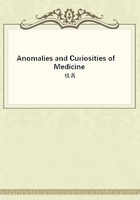
第87章
Schenck, Schurig, Bartholinus, Loder, and Ollsner report instances of diphallic terata; the latter case a was in a soldier of Charles VI, twenty-two years old, who applied to the surgeon for a bubonic affection, and who declared that he passed urine from the orifice of the left glans and also said that he was incapable of true coitus. Valentini mentions an instance in a boy of four, in which the two penises were superimposed. Bucchettoni speaks of a man with two penises placed side by side. There was an anonymous case described of a man of ninety-three with a penis which was for more than half its length divided into two distinct members, the right being somewhat larger than the left. From the middle of the penis up to the symphysis only the lower wall of the urethra was split. Jenisch describes a diphallic infant, the offspring of a woman of twenty-five who had been married five years. Her first child was a well-formed female, and the second, the infant in question, cried much during the night, and several times vomited dark-green matter. In lieu of one penis there were two, situated near each other, the right one of natural size and the left larger, but not furnished with a prepuce. Each penis had its own urethra, from which dribbled urine and some meconium.
There was a duplication of each scrotum, but only one testicle in each, and several other minor malformations.
Gore, reported by Velpeau, has seen an infant of eight and one-half months with two penises and three lower extremities. The penises were 4 cm. apart and the scrotum divided, containing one testicle in each side. Each penis was provided with a urethra, urine being discharged from both simultaneously. In a similar case, spoken of by Geoffroy-Saint-Hilaire, the two organs were also separate, but urine and semen escaped sometimes from one, sometimes from both.
The most celebrated of all the diphallic terata was Jean Baptista dos Santos, who when but six months old was spoken of by Acton.
His father and mother were healthy and had two well-formed children. He was easily born after an uneventful pregnancy. He was good-looking, well proportioned, and had two distinct penises, each as large as that of a child of six months.
Urination proceeded simultaneously from both penises; he had also two scrotums. Behind and between the legs there was another limb, or rather two, united throughout their length. It was connected to the pubis by a short stem 1/2 inch long and as large as the little finger, consisting of separate bones and cartilages. There was a patella in the supernumerary limb on the anal aspect, and a joint freely movable. This compound limb had no power of motion, but was endowed with sensibility. A journal in London, after quoting Acton's description, said that the child had been exhibited in Paris, and that the surgeons advised operation.
Fisher, to whom we are indebted for an exhaustive work in Teratology, received a report from Havana in July, 1865, which detailed a description of Santos at twenty- two years of age, and said that he was possessed of extraordinary animal passion, the sight of a female alone being sufficient to excite him. He was said to use both penises, after finishing with one continuing with the other; but this account of him does not agree with later descriptions, in which no excessive sexual ability had been noticed. Hart describes the adult Santos in full, and accompanies his article with an illustration. At this time he was said to have developed double genitals, and possibly a double bladder communicating by an imperfect septum. At adulthood the anus was three inches anterior to the os coceygeus. In the sitting or lying posture the supernumerary limb rested on the front of the inner surface of the lower third of his left thigh. He was in the habit of wearing this limb in a sling, or bound firmly to the right thigh, to prevent its unseemly dangling when erect. The perineum proper was absent, the entire space between the anus and the posterior edge of the scrotum being occupied by the pedicle.
Santos' mental and physical functions were developed above normal, and he impressed everybody with his accomplishments.
Geoffroy-Saint-Hilaire records an instance in which the conformation was similar to that of Santos. There was a third lower extremity consisting of two limbs fused into one with a single foot containing ten distinct digits. He calls the case one of arrested twin development.
Van Buren and Keyes describe a case in a man of forty-two, of good, healthy appearance. The two distinct penises of normal size were apparently well formed and were placed side by side, each attached at its root to the symphysis. Their covering of skin was common as far as the base of the glans; at this point they seemed distinct and perfect, but the meatus of the left was imperforate.
The right meatus was normal, and through it most of the urine passed, though some always dribbled through an opening in the perineum at a point where the root of the scrotum should have been. On lifting the double-barreled penis this opening could be seen and was of sufficient size to admit the finger. On the right side of the aperture was an elongated and rounded prominence similar in outline to a labium majus. This prominence contained a testicle normal in shape and sensibility, but slightly undersized, and surrounded, as was evident from its mobility, by a tunica vaginalis. The left testicle lay on the tendon of the adductor longus in the left groin; it was not fully developed, but the patient had sexual desires, erections, and emissions.
Both penises became erect simultaneously, the right more vigorously. The left leg was shorter than the right and congenitally smaller; the mammae were of normal dimensions.